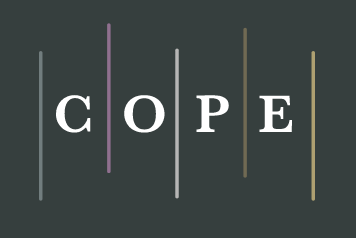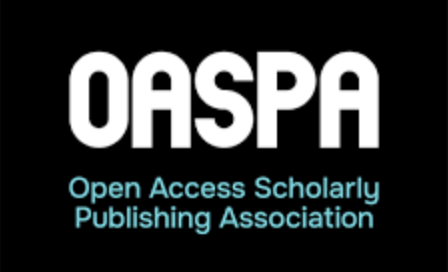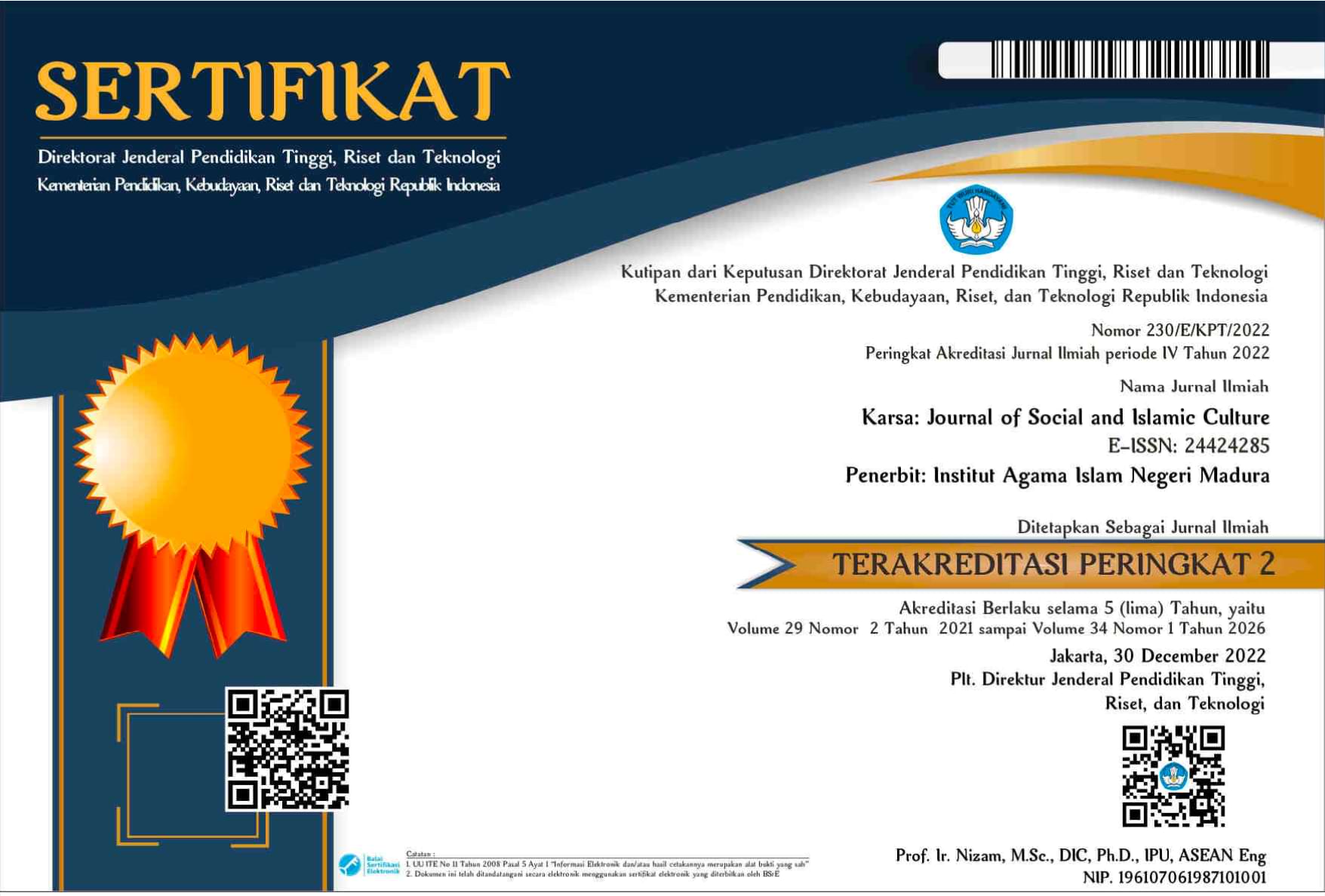The Cultural Message of Da’wah on The Jingkrak Sundang Dance in Central Java
 Abstract views: 463
,
Abstract views: 463
,
 PDF downloads: 304
PDF downloads: 304
Abstract
This study aims to discuss the message of da’wah that is contained in the Jinkrak Sundang Dance by using a qualitative descriptive approach and using the technique of semiotic analysis. Semiotics seeks to find the signs with meaning and know the sign systems such as language, movement, music, and pictures. As for the objects of the material to be analyzed is the movement of dance performed by the Jingkrak Sundang Dance artist, located in Magelang. A semiotic analysis on the Jingkrak Sundang Dance is performed on each stage or round: Mlayu, Nebah Bumi, Laku Telu Dadung Ngawuk, Pati, Mendem, and Nawur. Jingkrak Sundang Dance depicts the anger of the animals whose habitat was marred by the man’s hand, who was not responsible. The da’wah messages were found in denotation and connotation that many charged theological and anthropological. Theologically, the da’wah message explains the belief in the power of God as creators and regulators of whole natural life. In contrast, the da’wah message emphasizes the anthropocentric, seen many messages that urge to keep, love, and affection among fellow creatures. This study shows the conveyed to society to preserve nature and survival of all living beings. In addition, human behavior with good acts, help, and practice at once be an example for human beings and caring for the sustainability of the nature of the other.
Downloads
References
Anggito, Albi, and Johan Setiawan. Metodologi Penelitian Kualitatif. Sukabumi: Jejak, 2018.
Asmar, Afidatul. Pesan Da’wah dalam Tari “Pepe’-Pepeka Ri Makka” Pada Masyarakat Kampung Paropo Kota Makassar (Surabaya: UIN Sunan Ampel Surabaya, 2018)
Averroes. Faith & Reason in Islam: Averroes’s Exposition of Religious Arguments. Translated by Ibrahim Y. Najjar. London: Oneworld Publication, 2014.
Bashori. “Pemikiran Pendidikan Syeck Nawawi Al-Bantani.” Hikmah: Jurnal Pendidikan Agama Islam 6, no.1 (2017): 37-58. https://ojs. staituankutambusai.ac.id/index.php/hikmah/article/view/39.
Bogdan, Robert, and Steven J. Taylor. Introduction To Qualitative Research Methods A Phenomenological Approach To The Social Sciences. Toronto: A Wiley-Interscience Publication, John Wiley & Sons, 1975.
Creswell, John. W. Research Design: Qualitative, Quantitative, and Mixed Methods Approaches. California: Sage Publications, 2009.
Darwis, H., and H. Mas’ud. Kesehatan Masyarakat dalam Perspektif Sosioantropologi. Makassar: Sah Media, 2017.
Flew, Antony, and Roy Abraham Varghese. There Is A God: How the World’s Most Notorious Atheist Changed His Mind. New York: HarperOne, 2007.
Hadi, Y. Sumandiyo. Kajian Tari Teks dan Konteks. Yogyakarta: ISI Yogyakarta, 2007.
Hamka. Tafsir Al-Azhar. Singapura: Kerjaya Printing Industies Pte Ltd, 2003.
Hasan, Mohammad. Metodologi Pengembangan Ilmu Da’wah. Surabaya: Pena Salsabila, 2013.
Kafrawi. “Pemikiran Syekh Abdul Qadir Al-Jailani Tentang Ma’rifat.” Al-Liqo: Jurnal Pendidikan Islam 5, no. 1 (Juni 2020): 78-96. https://doi.org/10.46963/alliqo.v5i01.146.
Karim, Abdul. “Makna Ritual Kematian Dalam Tradisi Islam Jawa.” Sabda: Jurnal Kajian Kebudayaan 12, no. 2 (Desember 2017): 161-171. https://doi.org/10.14710/sabda.12.2.161-171.
Munir, Muhammad. Metode Da’wah. Jakarta: Kencana, 2006.
Opsantini, Rista Dewi. “Nilai-Nilai Islami dalam Pertunjukan Tari Sufi Pada Grup Kesenian Sufi Multikultur Kota Pekalongan.” Jurnal Seni Tari 3, no. 1 (2014): 1-13. https://journal.unnes.ac.id/sju/ index.php/jst.
Panuju, Redi. Pengantar Studi (Ilmu) Komunikasi. Komunikasi Sebagai Kegiatan. Komunikasi sebagai Ilmu. Jakarta: Kencana, 2018.
Pratiwi, Widhi Salika. Kesenian sebagai Media Da’wah Sunan Kalijaga. Lampung: UIN Raden Intan, 2020.
Shihab, Quraish. “Islam dan Seni” (M. Quraish Shihab Oficial Website). Accessed January 20, 2021. https://quraishshihab.com/akhlak/ islam-dan-seni/.
Rosana, Mira. “Kebijakan Pembangunan Berkelanjutan Yang Berwawasan Lingkungan Di Indonesia.” Kelola: Jurnal Ilmu Sosial Politik 1, no. 1 (2018): 148-163. https://doi.org/10.15575/ jk.v1i1.4128.
Safrilsyah and Fitriani. “Agama dan Kesadaran Menjaga Lingkungan.” Substantia: Jurnal Ilmu-Ilmu Ushuluddin 16, no. 1 (April 2014): 61-78. https://doi.org/10.22373/substantia.v16i1.4918.
Sakdiah. “Karakteristik Kepemimpinan Dalam Islam (Kajian Historis Filosofis) Sifat-Sifat Rasulullah.” Jurnal Al-Bayan: Media Kajian dan Pengembangan Ilmu Da’wah 22, no.1 (June 2016): 29-49. https://doi.org/10.22373/albayan.v22i33.636.
Suparlan, Henricus. “Filsafat Pendidikan Ki Hadjar Dewantara dan Sumbangannya bagi Pendidikan Indonesia.” Jurnal Filsafat 25, no.1 (Februari 2015): 56-74. https://doi.org/10.22146/jf.12614.
Thalhah, H.M., and Achmad Mufid. Fiqih Ekologi. Yogyakarta: Total Media, 2008.
Utama, Achmad Iqbal Satria. Kosmologi Penciptaan Alam Semesta (Studi Komparatif Antony Flew dan Ibn Rushd). (MA thes., UIN Sunan Ampel, 2019).
Utina, Ramli, Elya Nusantri, Abubakar Sidik Katili, and Yoan Tamu. Ekosistem dan Sumber Daya Alam Pesisir Penerapan Pendidikan Karakter Konservasi. Yogyakarta: Deepublish, 2018.
Yanti, Fitri. “Komunikasi Da’wah dalam Kesenian Nasyid.” Al-Mishbah: Jurnal Ilmu Da’wah dan Komunikasi 12, no. 2 (Desember 2016): 211-231. https://almishbahjurnal.com/index. php/almishbah/article/view/71.
The journal operates an Open Access policy under a Creative Commons Non-Commercial Share-Alike license. Authors who publish with this journal agree to the following terms:
- Authors retain copyright and grant the journal right of first publication with the work simultaneously licensed under a Creative Commons Attribution License that allows others to share the work with an acknowledgement of the work's authorship and initial publication in this journal.
- Authors are able to enter into separate, additional contractual arrangements for the non-exclusive distribution of the journal's published version of the work (e.g., post it to an institutional repository or publish it in a book), with an acknowledgement of its initial publication in this journal.
- Authors are permitted and encouraged to post their work online (e.g., in institutional repositories or on their website) prior to and during the submission process, as it can lead to productive exchanges, as well as earlier and greater citation of published work.





















